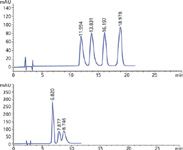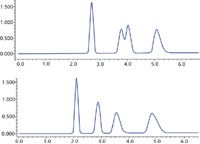Unique Selectivity of a Four Component Mixture Using Tris-(3,5-dimethylphenyl) Carbamoyl Amylose Chiral Stationary Phases (CSPs) Under Normal Phase and SFC Conditions
Regis Technologies, Inc.
Chiral separations of multicomponent mixtures of enantiomers and diastereomers are often difficult to resolve by a single isocratic method. The inherent variability in chemically equivalent CSPs can contribute as a factor in developing a suitable LC or SFC method and resolve the individual isomers.
A proprietary compound mixture recently screened consisted of two diastereomers and their respective enantiomers. We desired to develop analytical and preparative methods under SFC mobile phase. Upon initial screening, distinct differences between two chemically equivalent CSPs, RegisPack and a clone, were noted.
Under normal phase LC conditions the multicomponent mixture resolved well under CSP clone but not as well using RegisPack® (Figures 1 and 2).

Figure 1 (top): Sample: proprietary. Column: CSP Clone, 25 cm à 4.6 mm, 5 μm. Mobile phase: hexanes/ethanol/methanol 92:4:4. Flow rate: 1.5 mL/min. Figure 2 (bottom): Sample: proprietary. Column RegisPack, 25 cm à 4.6 mm, 5 μm. Mobile phase: hexanes/ethanol/methanol 92:4:4. Flow rate: 1.5 mL/min.
Both CSPs were also evaluated under SFC for both analytical method development and preparative for isomer isolation. Peak resolution was diminished for an isomer pair under the CSP clone and not suitable for SFC analytical or preparative work (Figure 3). However, the RegisPack resolution was noticeably enhanced and used for an SFC analytical method and a preparative separation (Figure 4).

Figure 3 (top): Sample: proprietary. Column: CSP Clone 25 cm à 4.6 mm, 5 μm. Mobile phase: CO2/methanol 80:20. Flow rate: 4.0 mL/min. Figure 4 (bottom): Sample: proprietary. Column: RegisPack 25 cm à 4.6 mm, 5 μm. Mobile phase: CO2/methanol 80:20. Flow rate: 4.0 mL/min.
Conclusion
Differences in silica, the coating process, and packing are variables in the performances of chemically equivalent chiral stationary phases. The differences tend to be negligible in most circumstances. However, compound specific applications consisting of complex or multicomponent mixtures can be profoundly influenced by these differences and, thus, requires a direct comparison per separation project.
Regis Technologies, Inc.
8210 Austin Ave., Morton Grove, IL 60053
tel. (847) 583-7661, fax (847) 967-1214
Website: www.registech.com/chiral

SEC-MALS of Antibody Therapeutics—A Robust Method for In-Depth Sample Characterization
June 1st 2022Monoclonal antibodies (mAbs) are effective therapeutics for cancers, auto-immune diseases, viral infections, and other diseases. Recent developments in antibody therapeutics aim to add more specific binding regions (bi- and multi-specificity) to increase their effectiveness and/or to downsize the molecule to the specific binding regions (for example, scFv or Fab fragment) to achieve better penetration of the tissue. As the molecule gets more complex, the possible high and low molecular weight (H/LMW) impurities become more complex, too. In order to accurately analyze the various species, more advanced detection than ultraviolet (UV) is required to characterize a mAb sample.

.png&w=3840&q=75)

.png&w=3840&q=75)



.png&w=3840&q=75)



.png&w=3840&q=75)














